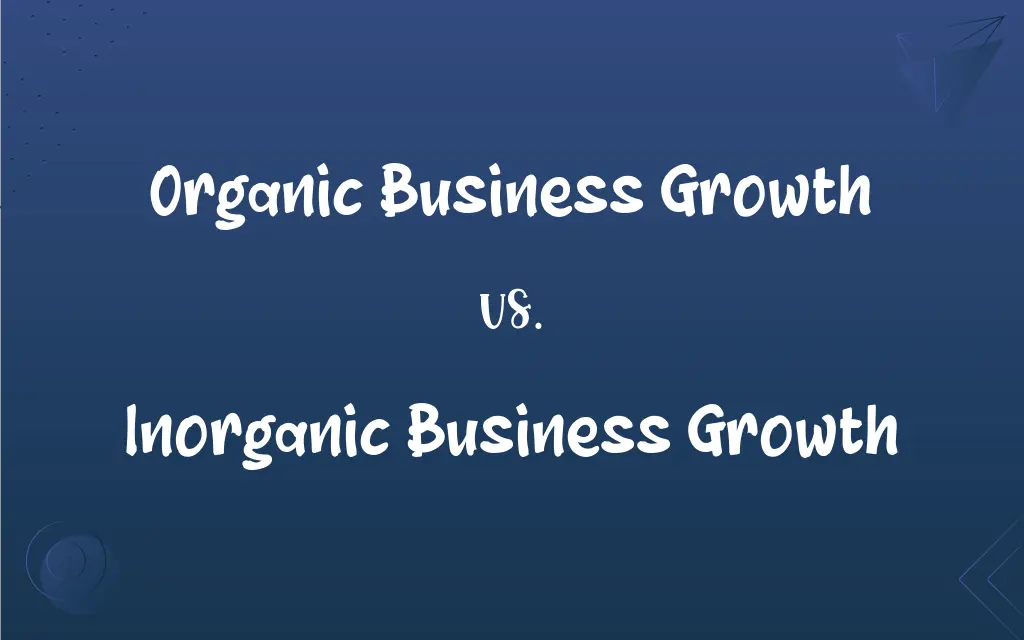Organic Business Growth vs. Inorganic Business Growth: What's the Difference?
Edited by Janet White || By Harlon Moss || Published on January 16, 2024
Organic business growth is expansion from internal resources, while inorganic business growth involves external methods like acquisitions and mergers.

Key Differences
Organic business growth is achieved through internal efforts, such as increasing sales, improving products, or expanding market reach. In contrast, inorganic business growth typically involves external strategies, like acquiring other companies or forming partnerships.
Organic growth is often a slower, more sustainable process, relying on the company’s own capabilities and resources. Inorganic growth, however, can provide rapid expansion but may involve integration challenges and higher risks.
The focus of organic growth is on building customer base, enhancing brand value, and strengthening product offerings. Inorganic growth, on the other hand, often aims at quickly increasing market share, diversifying risk, and gaining new competencies.
Organic growth reflects a company's fundamental strength and is often seen as a long-term strategy. Inorganic growth can dramatically change a company’s profile and market position in a short period.
Organic growth maintains a company's original culture and operational ethos, while inorganic growth, especially through acquisitions, can lead to a blend or clash of different corporate cultures and systems.
ADVERTISEMENT
Comparison Chart
Means of Growth
Internal development and expansion
Acquisitions, mergers, partnerships
Speed of Growth
Generally slower and more gradual
Can be rapid and immediate
Risk Level
Lower risk, as it relies on existing strengths
Potentially higher risk due to integration challenges
Impact on Culture
Maintains company culture
Can change or blend company culture
Long-term Sustainability
Often seen as more sustainable
May face challenges in sustainability
ADVERTISEMENT
Organic Business Growth and Inorganic Business Growth Definitions
Organic Business Growth
Growth achieved through expanding existing business operations.
The company's organic business growth was evident in its increased sales volume.
Inorganic Business Growth
Growth achieved through mergers, acquisitions, or takeovers.
The company's rapid expansion was due to its inorganic business growth strategy of acquiring smaller competitors.
Organic Business Growth
Expansion from a company's own resources and capabilities.
By enhancing its product line, the company achieved organic business growth.
Inorganic Business Growth
Rapid scaling of a business through external means.
Their inorganic business growth included forming strategic partnerships.
Organic Business Growth
The natural expansion of a business by building on its core competencies.
Their organic business growth was fueled by entering new markets.
Inorganic Business Growth
Expansion by integrating external entities or resources.
The merger with a leading tech firm marked significant inorganic business growth.
Organic Business Growth
Incremental growth from a company's inherent business activities.
Investing in research and development contributed to the company's organic business growth.
Inorganic Business Growth
Expansion that is not rooted in the company’s existing operations.
The acquisition of a new brand signaled a shift towards inorganic business growth.
Organic Business Growth
Growth derived internally, typically through increased output or sales.
The company's focus on customer service drove its organic business growth.
Inorganic Business Growth
Enhancement of business capacity by external investments or alliances.
Joining forces with an international distributor was part of their inorganic business growth plan.
FAQs
Is organic growth always slower than inorganic?
Typically, yes, as it relies on internal resources and capacities.
Why do companies prefer organic growth?
For sustainable development and to maintain their core values and culture.
What is organic business growth?
Expansion from a company’s own resources, such as increasing sales or improving products.
Can inorganic growth be part of a long-term strategy?
Yes, though it often focuses on immediate expansion and market positioning.
How does inorganic business growth differ?
It involves external strategies like mergers, acquisitions, or partnerships.
Can a company combine organic and inorganic growth strategies?
Yes, many successful companies use a mix of both strategies.
What role does innovation play in organic growth?
It’s crucial for creating new products and improving processes, driving growth.
Can inorganic growth improve competitiveness?
Yes, by rapidly acquiring new capabilities and market share.
Does organic growth require more time investment?
Generally, as it relies on building and expanding internal resources.
How does organic growth impact a company's culture?
It tends to maintain and strengthen the existing company culture.
How important is customer loyalty in organic growth?
Very, as it drives repeat business and sustainable growth.
What challenges can arise from inorganic growth?
Issues with integration, cultural alignment, and financial strain.
What risks are involved in inorganic business growth?
Integration challenges, cultural conflicts, and financial risks from acquisitions.
How does customer base change with organic growth?
It usually grows gradually and loyally alongside the company.
What financial strategies support inorganic growth?
External funding, stock offerings, or leveraging debt for acquisitions.
Do acquisitions always lead to inorganic growth?
Predominantly, as they involve external expansion.
Is organic or inorganic growth better for small businesses?
Often, organic growth is more feasible and sustainable for small businesses.
How do employees typically react to inorganic growth?
It can be mixed, often depending on how well the integration is managed.
Does market condition affect the choice of growth strategy?
Yes, companies may choose different strategies based on market opportunities and challenges.
Can inorganic growth lead to diversification?
Yes, often companies pursue it to diversify their products or markets.
About Author
Written by
Harlon MossHarlon is a seasoned quality moderator and accomplished content writer for Difference Wiki. An alumnus of the prestigious University of California, he earned his degree in Computer Science. Leveraging his academic background, Harlon brings a meticulous and informed perspective to his work, ensuring content accuracy and excellence.
Edited by
Janet WhiteJanet White has been an esteemed writer and blogger for Difference Wiki. Holding a Master's degree in Science and Medical Journalism from the prestigious Boston University, she has consistently demonstrated her expertise and passion for her field. When she's not immersed in her work, Janet relishes her time exercising, delving into a good book, and cherishing moments with friends and family.































































